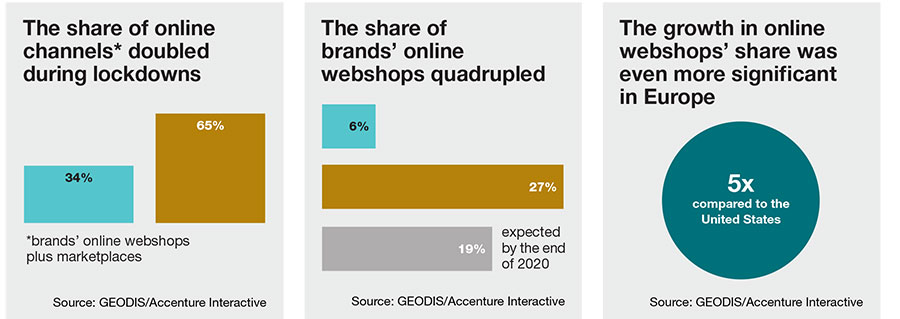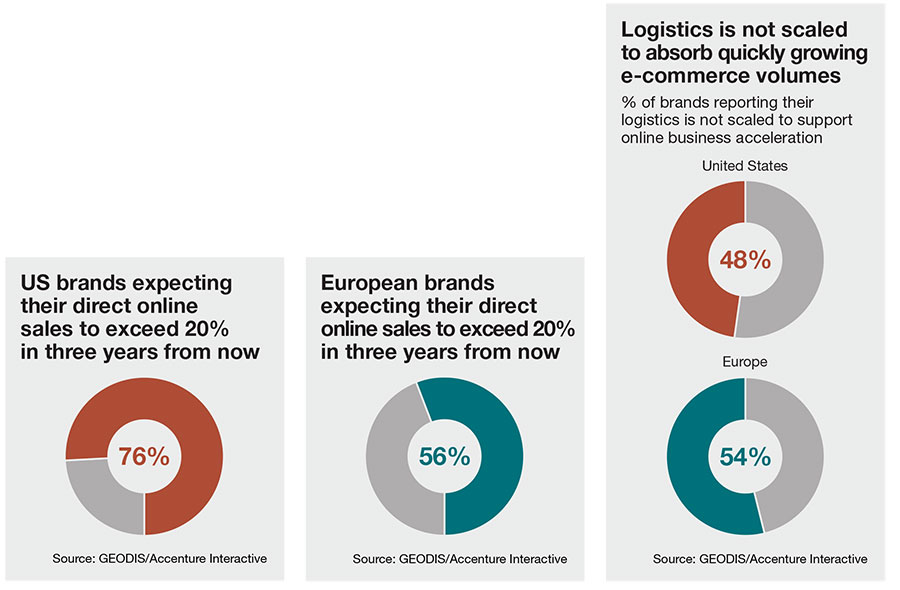Third Party Logistics (3PL): More critical than ever
With the meteoric rise of e-commerce around the globe, innovative capabilities for last-mile delivery, reverse logistics and warehousing will be increasingly important. However, investing in new capabilities is daunting and increasingly harder to justify, which makes finding the right third-party logistics providers for your needs more essential than ever—here’s why.
The events of 2020 created a dramatic tipping point for supply chains. Even before the COVID-19 pandemic struck, supply chains had become increasingly complex and struggled to meet high demands for goods. At the beginning of the crisis, the supply chain’s role as the lifeline of humanity—getting goods and services to all types of customers quickly, safely and securely—became immediately clear.
Under this spotlight also came the realization that many companies weren’t fully prepared for a global pandemic of this nature, and the supply chain’s ability to deliver was greatly affected across the world. Companies were forced to quickly fast track their efforts to build intelligent supply chains that are not only efficient, but also customer-centric, resilient and responsible with greater transparency, increased visibility and faster decision-making—to ultimately better serve their customers and communities.
Now, in 2021, supply chains across all industries are facing continued disruption on a global scale. The pandemic accelerated consumer demand for e-commerce and faster delivery options, adding to the pressure on shippers.
A recent survey by Accenture and GEODIS of 200 large retail and consumer goods brands found that companies expect the shift to online sales—especially in selling directly on their own websites—to remain even after the pandemic subsides. However, more than half (52%) believe their logistics capabilities are not scaled to absorb quickly growing e-commerce volumes.
To continuously adapt to changing markets and economic conditions, shippers need to prioritize value chain transformation. They need to adopt new ways of working that build greater levels of agility, resiliency and sustainability—all while proactively managing costs.
New innovative capabilities for last-mile delivery, reverse logistics and warehousing will be increasingly important. However, investing in new capabilities is daunting and increasingly harder to justify, which makes finding the right third-party logistics (3PL) providers for their needs more essential than ever.
Changing 3PL dynamics
This year, a key priority for shippers will be to evaluate 3PLs to ensure that they get the most out of those relationships as the recovery unfolds. Historically, shippers have relied on 3PLs to cost-effectively manage asset-based activities such as transportation and warehousing.
Those relationships have expanded over the past several years, as 3PLs offer critical, real-time visibility and reporting. They also help shippers make significant shifts in their business and drive innovation that enables growth. Our Technology Vision 2020 for Freight & Logistics study found that 74% of freight and logistics executives believe that the stakes for innovation have never been higher. Getting it right will require new ways of innovating with 3PLs.
The 3PL market has become increasingly crowded and fragmented with a mix of global and local providers, as well as new players emerging with more user-friendly services and digital platforms. Over the past several years, global e-commerce behemoths have moved into logistics in a big way, competing with incumbent providers while significantly raising the bar in customer expectations.
There has also been a rise of new digital service providers with their sights set firmly on the logistics market. Capitalizing on the growing disconnect between logistics needs and delivered experience, these specialized startup businesses provide key aspects of transparency and automation in the logistics value chain, from initial quote and booking, through real-time track and trace, to end fulfillment.
The competitive landscape means shippers have more bargaining power, which is a positive thing, but the wide array of options can be difficult to choose from. Shippers need to spend more time evaluating contracts to find the right 3PL for their needs, which in many cases expands beyond logistics services to more holistic supply chain management solutions. They should also take into consideration how 3PLs can help meet sustainability commitments to reduce social risk, carbon emissions and waste across the value chain.
Many shippers now expect 3PLs to be an integrated component to their value chain—helping with everything from addressing capacity challenges to market expansion and efforts to get closer to customers to accelerating digital transformation of their supply chains. Let’s dig a bit deeper into each of these areas and the role of 3PLs.

Addressing capacity challenges. Distribution has been disrupted on a global scale and the challenges of moving freight will not relent in 2021. With ongoing surges in demands, periods of capacity constraints in air and truck modes, and rate challenges in ocean, shippers have to constantly evaluate their options.
Moreover, increased border controls and customs regulations will result in longer wait times and changing capacities for long-haul and last-mile fulfillment will create extreme challenges.
Data and insights from Seabury Consulting on air, express and ocean freight demand and capacity shows that capacities have been steadily increasing and are, across the board, approaching pre-pandemic levels. However, increases in demand have outpaced the recovery in capacity and rates have also been steadily increasing across modes.
This challenging market means that shippers are under even more pressure to strategically manage the capacity needed across air, ocean and truck and enable rapid decision-making based on the mode options available to build and maintain flexibility.
Shippers will continue to face surges in demand periods of capacity constraints in air and truck modes and rate challenges in ocean. With access to large carrier networks, 3PLs can be a great resource for shippers looking to find capacity.
Evaluating growth opportunities. As shippers look to build customer-centric supply chains that enable new growth, their 3PL relationships will be critical to enabling the specific segmentation strategies they have on balancing service level and cost with flexibility.
For example, as shippers face increasing demands for more customized products and services, faster order fulfillment times, and smaller lot sizes, they need segment capabilities to service that segment differently than large bulk segments.
That level of segmentation requires increased visibility to demand requirements to align physical supply chain infrastructure and capabilities with dynamic planning and decision-making. Shippers need to evaluate which 3PL partners have capabilities that meet the needs of different segments.
Shippers can also leverage 3PLs as they consider their existing market presence and opportunities to expand into new markets. Even before the pandemic, companies were rethinking their sourcing and logistics networks and this disruption fast-tracked a focus on re- and near-shoring to reduce future risk, lower total cost of ownership, and ultimately get closer to the end-consumer.
Shippers can leverage the global footprint and market expertise of 3PLs to evaluate where they need to play. In the meantime, 3PLs can also help companies make better use of their physical assets. For example, we’ve seen 3PLs working with retailers to integrate their stores into e-commerce networks, allowing their physical locations to serve as fulfillment centers, pick-up points, shipment facilities, delivery centers and return centers.

Building resilience with digital transformation. After facing significant disruption early in the pandemic, many shippers have started taking a proactive approach to risk by implementing new initiatives to increase visibility and resilience. Shippers are also looking at creative solutions for stress testing their supply chains and logistics networks.
Last year, Accenture and MIT announced a supply chain stress test that assesses operational and financial risks created by major market disruptions. Inspired by the crucial financial services industry stress tests that became compulsory after the 2008 financial crisis, the supply chain stress test enables companies to run more than 40 scenarios at one time, providing unprecedented visibility into where and how their supply chains will be impacted during a major disruption.
In 2021, 3PLs play a critical role in helping shippers with end-to-end inventory visibility, real-time order monitoring and super-reverse logistics. These capabilities allow shippers to make more informed, strategic decisions and act quickly with greater precision, fact-based certainty and full alignment to their overarching business strategy.
The increased volatility and complexity in today’s business environment has created the need for an agile, streamlined and hyper-responsive supply chain that provides the ability to more accurately forecast and quickly and efficiently fulfill customer demands.
With advanced analytics, machine learning and automated offerings for pricing, booking and documentation, among other capabilities, shippers can rely on their 3PLs for better visibility and faster decision-making and reporting across all operations.
For example, a 3PL can help identify ports that are congested or even closed due to a natural disaster and quickly help shippers diverge trade to different ports. That type of insight can allow for proactive process adaptation to quickly redirect operations to meet demands in a timely way.
No one knows what challenges we will face in 2021.
But one thing is certain: 3PLs will be more critical than ever and shippers will need to prioritize better leveraging their 3PL relationships. The companies that focus on improving collaboration with 3PLs will better serve customers and ultimately uncover new avenues for purpose-led growth.

Article Topics
3PL News & Resources
LM Podcast Series: Assessing the freight transportation and logistics markets with Tom Nightingale, AFS Logistics Investor expectations continue to influence supply chain decision-making XPO opens up three new services acquired through auction of Yellow’s properties and assets FTR’s Trucking Conditions Index weakens, due to fuel price gains LM Podcast Series: Examining the freight railroad and intermodal markets with Tony Hatch Supply Chain Stability Index sees ‘Tremendous Improvement’ in 2023 TD Cowen/AFS Freight presents mixed readings for parcel, LTL, and truckload revenues and rates More 3PLLatest in Logistics
LM Podcast Series: Assessing the freight transportation and logistics markets with Tom Nightingale, AFS Logistics Investor expectations continue to influence supply chain decision-making The Next Big Steps in Supply Chain Digitalization Warehouse/DC Automation & Technology: Time to gain a competitive advantage The Ultimate WMS Checklist: Find the Perfect Fit Under-21 driver pilot program a bust with fleets as FMCSA seeks changes Diesel back over $4 a gallon; Mideast tensions, other worries cited More LogisticsSubscribe to Logistics Management Magazine

Find out what the world's most innovative companies are doing to improve productivity in their plants and distribution centers.
Start your FREE subscription today.
April 2023 Logistics Management

Latest Resources
















